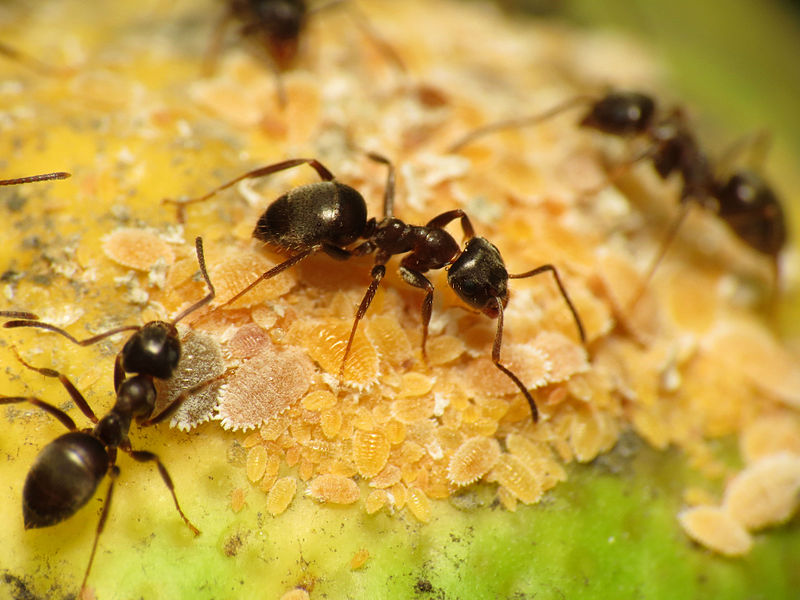Sunday, 30 June 2019
Saturday, 29 June 2019
YOU
Written by Gracie, another bull terrier owner following the loss of her dog. The words are so true.
So long ago
No words to say
I dream of you
I dream so far away
The day you left
My sky turned grey
Stand alone
The price we pay
No words to say
I dream of you
I dream so far away
The day you left
My sky turned grey
Stand alone
The price we pay
Shadows they move
Across the sky
Look out the window
Never wondering why
This veil we see
That we call life
We look through
Until the day we die
Across the sky
Look out the window
Never wondering why
This veil we see
That we call life
We look through
Until the day we die
Sweet memories
Are all I have
No one can take
They'll never go away
Now I know that
Nothing's as it seems
You are alive
Inside of me
I get no rest
Until my last breath...
Are all I have
No one can take
They'll never go away
Now I know that
Nothing's as it seems
You are alive
Inside of me
I get no rest
Until my last breath...
The Cemetery Caretaker Who Covered His Cottage in Mind-Bending Mosaics
Alexxa Gotthardt
Jan 16, 2018 4:38pm
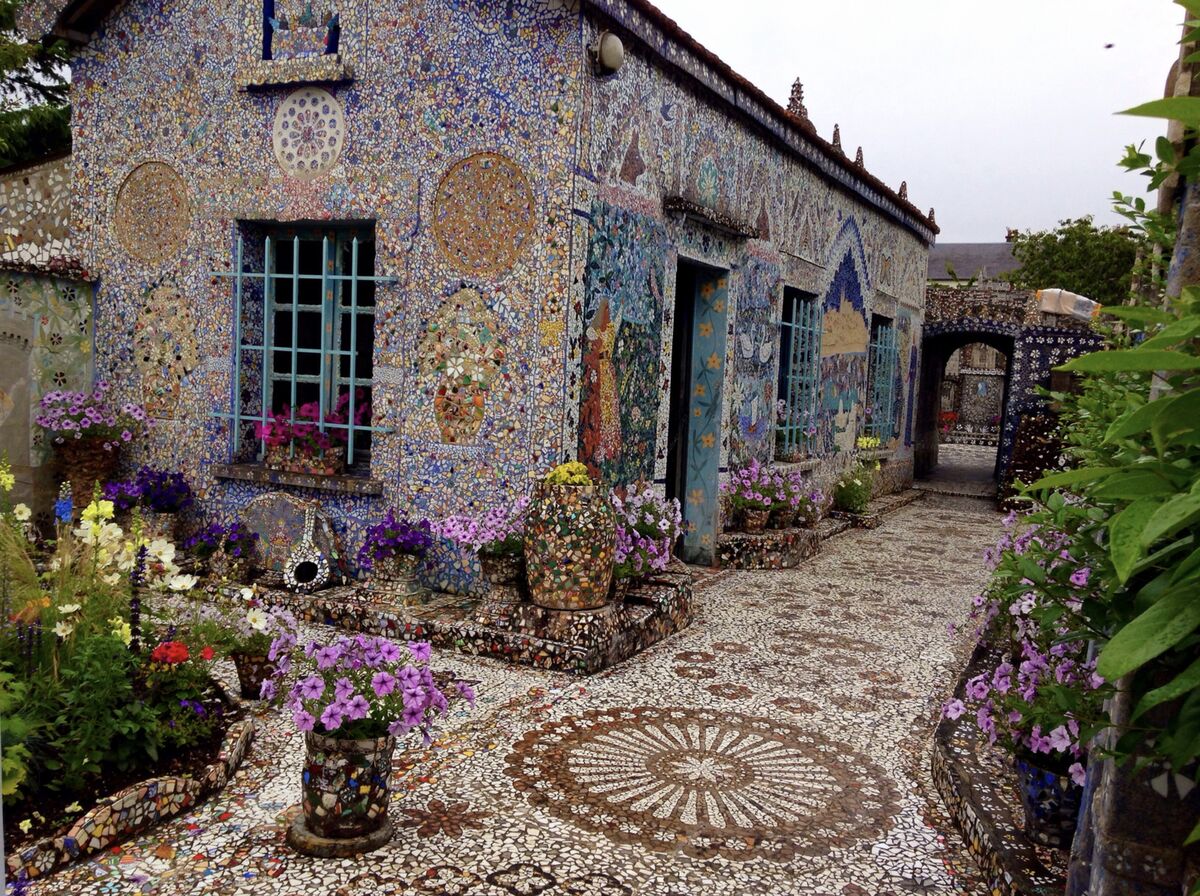
Photo by Michael P Chang, MD, via Flickr.
Raymond Isidore didn’t plan on becoming an artist—let alone a sculptor who would go on to cover nearly every surface of his small home with glittering mosaics. But after a fateful stroll in 1938, when a shiny piece of broken crockery caught his eye, Isidore devoted the majority of the remainder of his life on the outskirts of Chartres, France, to the creation of one of the world’s most unique homes—an ecstatic expression of the untrained artist’s bursting imagination.
Isidore was born into a humble family in Chartres in 1900, and as a young man landed a position as the caretaker of a local cemetery. By all accounts, he led a provincial life; he married a woman roughly 10 years his senior and bought a humble plot of land not far from the famed Chartres Cathedral. There, Isidore built what began as a simple cottage, but soon transformed into his masterwork, known as La Maison Picassiette, which still stands and is accessible to the public today.

Photo by @little_miaow, via Instagram.
With the passion and discerning eye of a new collector, Isidore began his project by pocketing all of the broken bits of pottery and glass he could find. His sources were the fields and trash repositories around his home; he believed that “what people disdain and reject in quarries and dumps can still serve,” he once explained of his growing cache of discards.
At first, he had no objective other than to keep the eye-catching shards. “I picked them up without any specific intention, for their colors and their flicker,” he later recalled. “I sorted the good, [discarded] the bad. I piled them up in a corner of my garden.”
It was a dream that came to him one night that encouraged the middle-aged man to reconstitute his pile of fragments into something new, he later told journalist Robert Giraud. “The night dictated what I had to do,” he recalled. “I saw my motive before me as if it really existed.…Pieces of porcelain or faience were within reach, ready to use.”
The mosaics that resulted surprised even their creator: “I, who have never known how to draw in my life, I do not understand how, yet I arrived at such a result,” he continued.
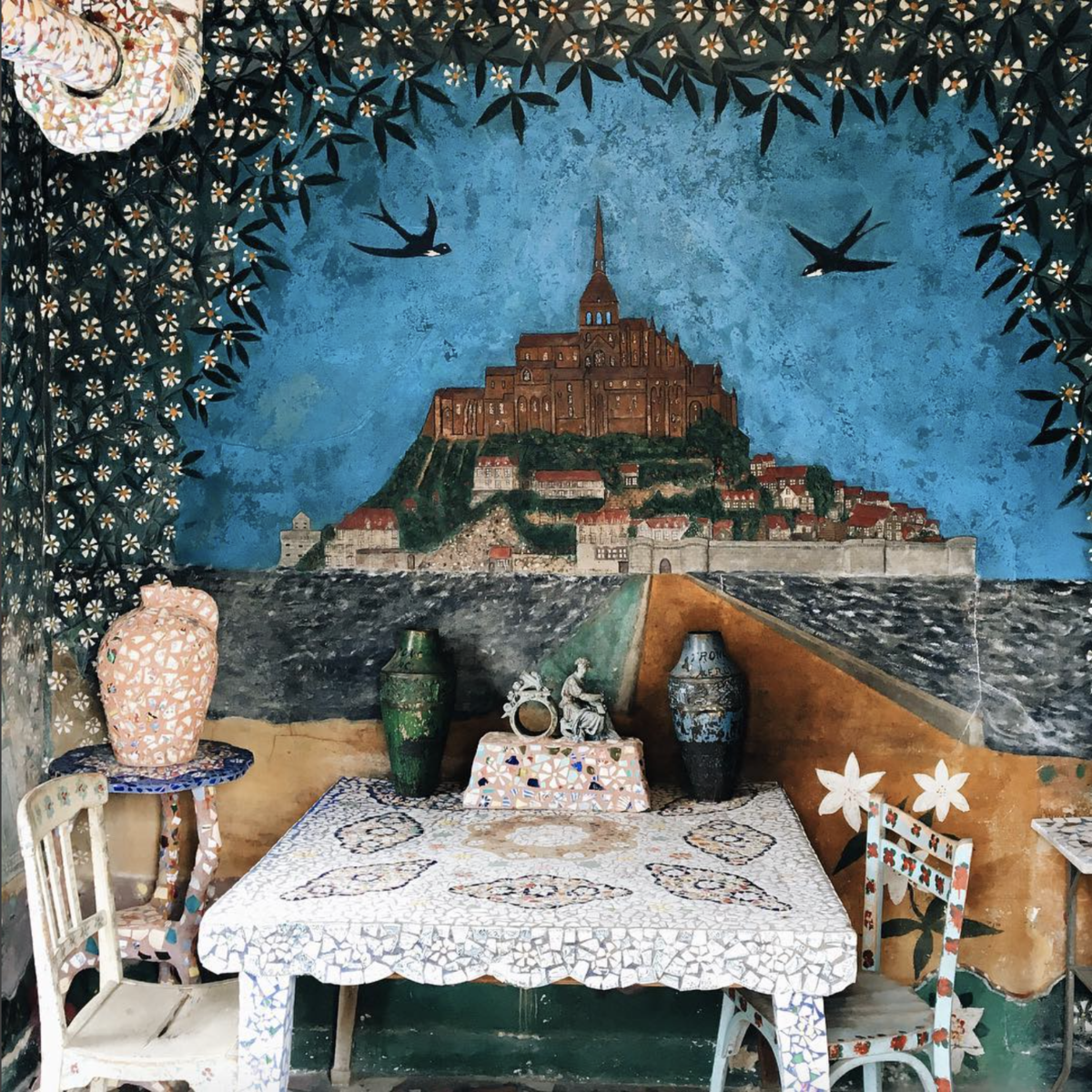
Photo by @passionchateau, via Instagram.
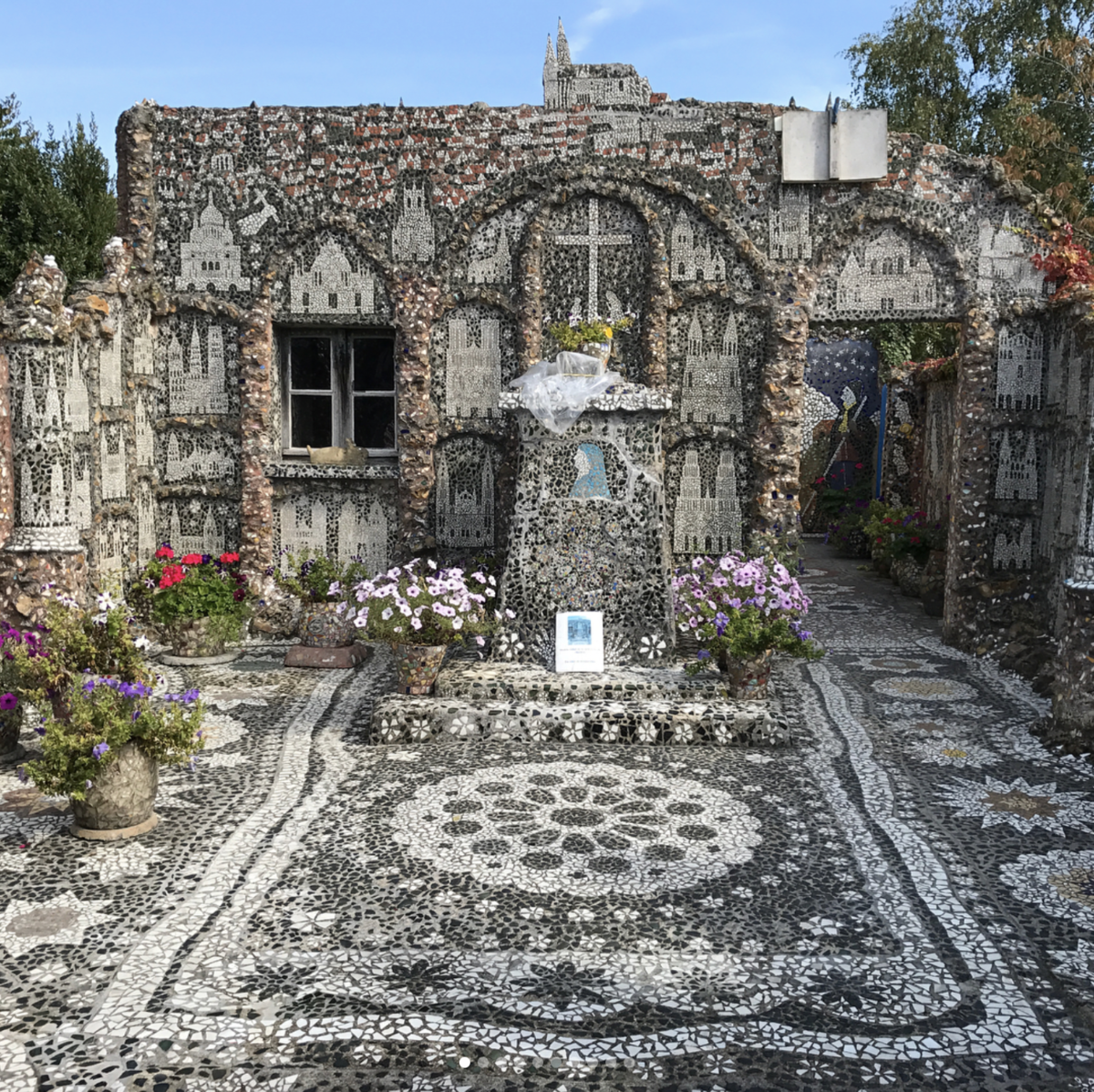
Photo by @guetteururbain, via Instagram.
Isidore first set to work on the interior walls of his house, often covering them with intricate patterns of flowers and birds, created from ragged ceramic pieces in a multitude of colors. Surfaces not swathed in tile creations were painted with flora and fauna or sun-bathed vistas. One fresco, like a trompe l’oeil window into paradise, shows an island topped with palace-cum-cathedral. The landmass is surrounded by careening swallows and a calm sea.
After he’d filled the walls with mosaic, he moved to the ceilings, floors, and even furniture: from the kitchen table and bed, to a sewing machine and side chair. Every corner and object—even the most minute—became encased in ceramic and glass collage or painted patterns, all depicting the most joyous, colorful aspects of nature, everyday life, and biblical scenes. Then, he moved on to the exterior.
As Isidore's his creation grew, some say that he became known by cynical neighbors as Picassiette—a term that’s been interpreted as a derisive portmanteau, joining pique (or steal) with assiette (or plate). But this teasing didn’t deter Isidore from continuing his work, and as his mosaics began to spread across the facade of his house, skepticism turned to awe. The cottage began to shimmer with swans, ships, bees, bursting floral arrangements, and an impressive depiction of the Chartres Cathedral, all pieced together from kaleidoscopic pieces of pottery.

Photo by @aarchange66, via Instagram.
By 1960, word of La Maison Picassiette had spread as far as the United States. In December of that year, the magazine Popular Mechanics ran a story headlined “Mosaic House” on Isidore’s life’s work. In one photo that accompanied the article, he wears a beret while creating a butterfly from bits of glass. By that point, he’d been building upon his mosaic for over two decades—it decorated not only the exterior of the Isidore homestead, but also the property’s gates, pathways, and gardens.
He even built additional structures on the property—including a chapel and what he called his summer house—so that he could blanket them, too. These structures boast the most tantalizing and detailed surfaces of La Maison Picassiette. In the chapel, garlands of leaves and abstract patterns surround a large cross dotted with rosebuds and a nativity scene. The west wall shows a secular scene depicting the countryside, where a woman, a shepherd, a dog, chickens, rabbits, and plows mingle.
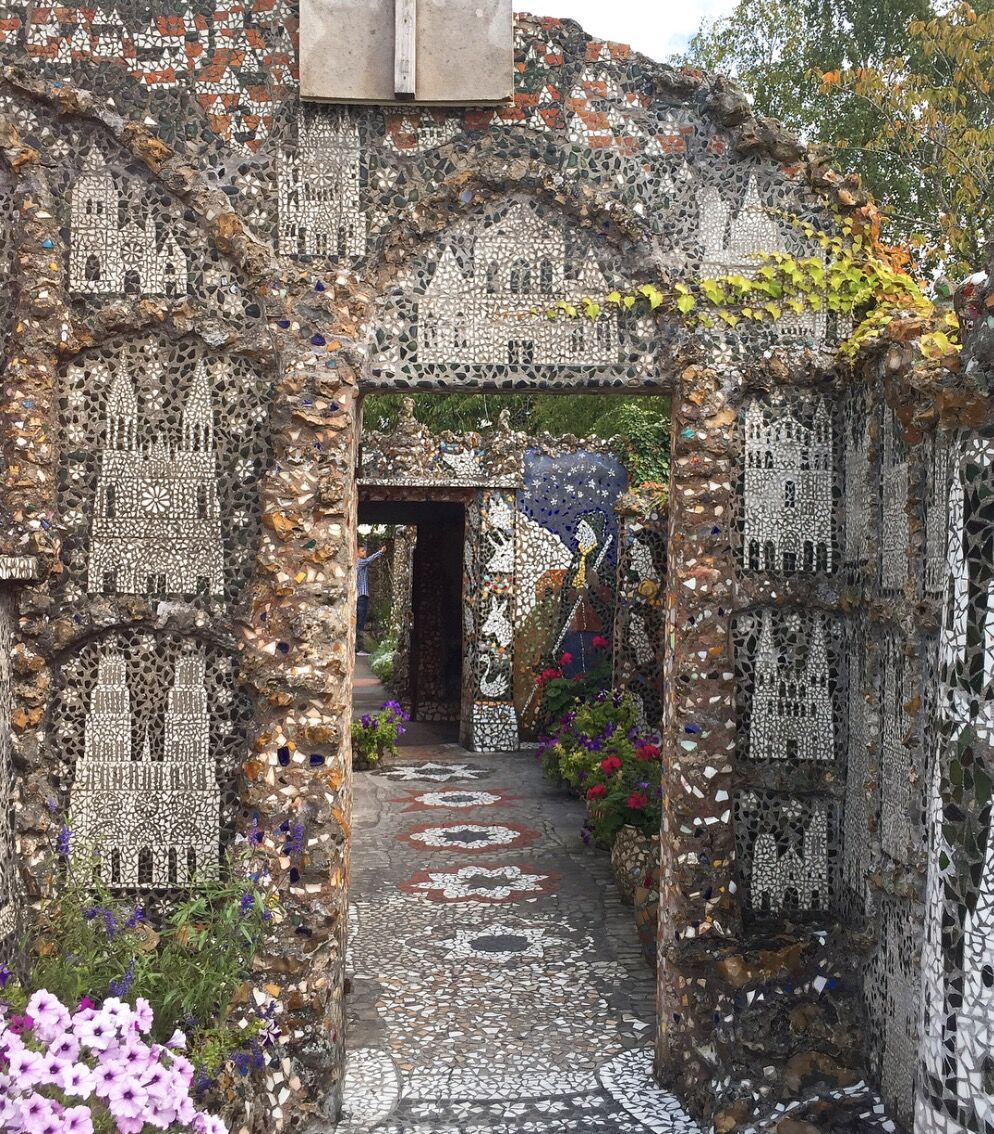
Photo by @sugyung.suzanne, via Instagram.
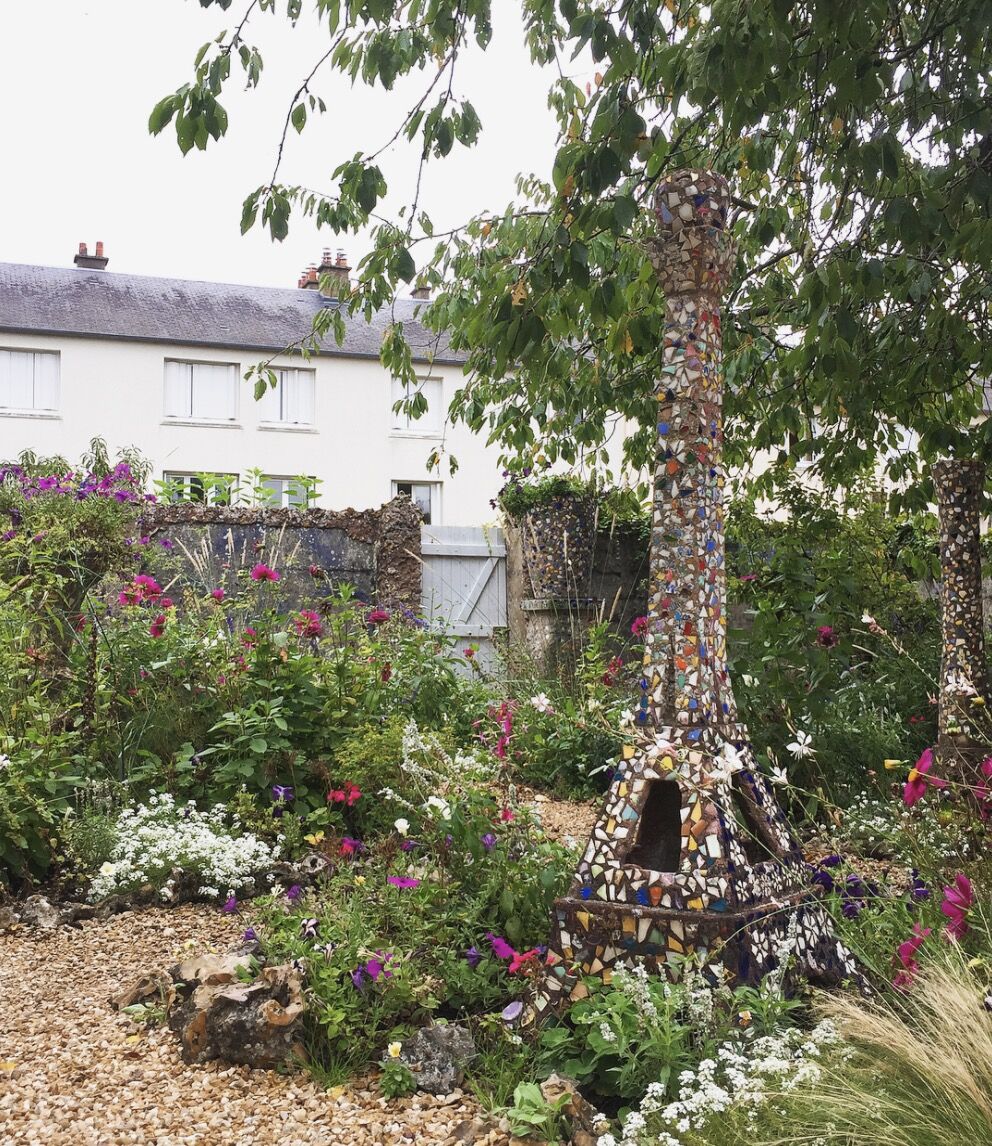
Photo by @sugyung.suzanne, via Instagram.
The summer house, on the other hand, became a canvas for mosaiced murals representing whole cities and some of the world’s greatest buildings. One wall bordering the structure, part of what is known as the black courtyard, is covered primarily in shards of black glass and white china. These bits come together to depict cathedrals and other places of worship copied from postcards and Isidore’s own surroundings. On another exterior surface of the building, a frieze depicting Jerusalem makes way for a sea of famous structures, like the Leaning Tower of Pisa and the Colosseum. At the base of this elaborate fresco, Isidore placed a throne: This is where he would sit and admire his creation.
By the end of his life, in 1964, Isidore had acquired another nickname, too: Picasso Assiette. The name was fitting in part because
Pablo Picasso
himself visited La Maison Picassiette in 1954. But the title also recognized the Isidore’s unbridled creativity, which fueled him to forge a shimmering paradise from bits of pottery.
Alexxa Gotthardt is a contributing writer for Artsy.
Jan 16, 2018 4:38pm

Photo by Michael P Chang, MD, via Flickr.
Raymond Isidore didn’t plan on becoming an artist—let alone a sculptor who would go on to cover nearly every surface of his small home with glittering mosaics. But after a fateful stroll in 1938, when a shiny piece of broken crockery caught his eye, Isidore devoted the majority of the remainder of his life on the outskirts of Chartres, France, to the creation of one of the world’s most unique homes—an ecstatic expression of the untrained artist’s bursting imagination.
Isidore was born into a humble family in Chartres in 1900, and as a young man landed a position as the caretaker of a local cemetery. By all accounts, he led a provincial life; he married a woman roughly 10 years his senior and bought a humble plot of land not far from the famed Chartres Cathedral. There, Isidore built what began as a simple cottage, but soon transformed into his masterwork, known as La Maison Picassiette, which still stands and is accessible to the public today.

Photo by @little_miaow, via Instagram.
With the passion and discerning eye of a new collector, Isidore began his project by pocketing all of the broken bits of pottery and glass he could find. His sources were the fields and trash repositories around his home; he believed that “what people disdain and reject in quarries and dumps can still serve,” he once explained of his growing cache of discards.
At first, he had no objective other than to keep the eye-catching shards. “I picked them up without any specific intention, for their colors and their flicker,” he later recalled. “I sorted the good, [discarded] the bad. I piled them up in a corner of my garden.”
It was a dream that came to him one night that encouraged the middle-aged man to reconstitute his pile of fragments into something new, he later told journalist Robert Giraud. “The night dictated what I had to do,” he recalled. “I saw my motive before me as if it really existed.…Pieces of porcelain or faience were within reach, ready to use.”
The mosaics that resulted surprised even their creator: “I, who have never known how to draw in my life, I do not understand how, yet I arrived at such a result,” he continued.

Photo by @passionchateau, via Instagram.

Photo by @guetteururbain, via Instagram.
Isidore first set to work on the interior walls of his house, often covering them with intricate patterns of flowers and birds, created from ragged ceramic pieces in a multitude of colors. Surfaces not swathed in tile creations were painted with flora and fauna or sun-bathed vistas. One fresco, like a trompe l’oeil window into paradise, shows an island topped with palace-cum-cathedral. The landmass is surrounded by careening swallows and a calm sea.
After he’d filled the walls with mosaic, he moved to the ceilings, floors, and even furniture: from the kitchen table and bed, to a sewing machine and side chair. Every corner and object—even the most minute—became encased in ceramic and glass collage or painted patterns, all depicting the most joyous, colorful aspects of nature, everyday life, and biblical scenes. Then, he moved on to the exterior.
As Isidore's his creation grew, some say that he became known by cynical neighbors as Picassiette—a term that’s been interpreted as a derisive portmanteau, joining pique (or steal) with assiette (or plate). But this teasing didn’t deter Isidore from continuing his work, and as his mosaics began to spread across the facade of his house, skepticism turned to awe. The cottage began to shimmer with swans, ships, bees, bursting floral arrangements, and an impressive depiction of the Chartres Cathedral, all pieced together from kaleidoscopic pieces of pottery.

Photo by @aarchange66, via Instagram.
By 1960, word of La Maison Picassiette had spread as far as the United States. In December of that year, the magazine Popular Mechanics ran a story headlined “Mosaic House” on Isidore’s life’s work. In one photo that accompanied the article, he wears a beret while creating a butterfly from bits of glass. By that point, he’d been building upon his mosaic for over two decades—it decorated not only the exterior of the Isidore homestead, but also the property’s gates, pathways, and gardens.
He even built additional structures on the property—including a chapel and what he called his summer house—so that he could blanket them, too. These structures boast the most tantalizing and detailed surfaces of La Maison Picassiette. In the chapel, garlands of leaves and abstract patterns surround a large cross dotted with rosebuds and a nativity scene. The west wall shows a secular scene depicting the countryside, where a woman, a shepherd, a dog, chickens, rabbits, and plows mingle.

Photo by @sugyung.suzanne, via Instagram.

Photo by @sugyung.suzanne, via Instagram.
The summer house, on the other hand, became a canvas for mosaiced murals representing whole cities and some of the world’s greatest buildings. One wall bordering the structure, part of what is known as the black courtyard, is covered primarily in shards of black glass and white china. These bits come together to depict cathedrals and other places of worship copied from postcards and Isidore’s own surroundings. On another exterior surface of the building, a frieze depicting Jerusalem makes way for a sea of famous structures, like the Leaning Tower of Pisa and the Colosseum. At the base of this elaborate fresco, Isidore placed a throne: This is where he would sit and admire his creation.
By the end of his life, in 1964, Isidore had acquired another nickname, too: Picasso Assiette. The name was fitting in part because
Pablo Picasso
himself visited La Maison Picassiette in 1954. But the title also recognized the Isidore’s unbridled creativity, which fueled him to forge a shimmering paradise from bits of pottery.
Alexxa Gotthardt is a contributing writer for Artsy.
Plas Madoc Hall
The oldest record of a house at the site of plas madoc dates back to the time of welsh royalty & the principality of wales in the 12th century , it would of been a half-timbered dwelling at the time. The family name of Madoc ap Owain Gwynedd , David ap Llewellyn , ap Ednyfed Fychan were all linked to the earlier dwellings at the plas madoc site. Going into the 15th century a man named John who decended from the welsh lineage was the first to adopt the surname Lloyd ( John Lloyd ) he built a new house over the older one. The plas madoc estate going into the 16th century stayed in the possession of the Lloyd family , by 1620 the Plas Madoc Hall & Estate covered over 232 acres of land between the Wynstay and Plas Kynaston Estates and was inherited by Edward Lloyd whom was a Coroner for the County and decedent of Madoc family. The Plas Madoc Hall & Estate remained in the same family line through a succession of inheritances until the mid-1800’s when the high sheriff of the county George Hammond Whaley became the owner of the plas madoc estate , he added a few structural changes to the estate until his death in 1878. After the death of George Whaley The Plas Madoc Hall estate was sold to the powerful neighbouring family of the Wynn's Of the Wynnstay of Ruabon , going from the late 18th century into the 19th century Plas madoc hall had a few tennenants renting the property. One of the tennants was a man named Charles morris who was a secretary of the old firm of ' Hughes & Lancaster ' in acrefair , another tennant was a man named John Jones who was headmaster and Rhos-y-medre church school. Going into the 1960's the Plas Madoc Hall had fallen in to a poor state of repair and was derelict , in 1968 it was scheduled for demolition by the local authority to make way for the new project from the local council to provide a big Plas Madoc Housing Estate. Soon after Plas madoc hall was demolished and a new estate was created with completion in the 70's , the new Plas Madoc Housing Estate Scheme was for 550 units initially costing around £1.5 million pounds in 1970 that could be increased to 1000 units at a later date when more funds became available. The new plas madoc estate site was also added to greatly over the coming years with a big Leisure centre which would be popular for familys going swimming , also local shops were added to cater of the new community of plas madoc and also eventually there would be a supermarket known locally as leo's that would be in the commuity of plas masdoc. Present day plas madoc has gone through some changes with the supermarket leo's being demolished in the 90's and on the site of there now is a residentual complex known as plas telford , also many of the houses in plas madoc have been rennovated to an update standard from the 1970's look.
Also to add plas madoc get's it's name from Madoc ap Owain Gwynedd
Also it is said in the 16th century the Roundhead general himself Oliver Cromwell stayed for a night at plas madoc hall.
From “Winehouse”
by Kevin Young
Issue no. 204 (Spring 2013)
Issue no. 204 (Spring 2013)
The world is your lawyer.
Pawn-shop pearls.
Hair like telegraph wire.
My body my bed,
unmade. My skin’s
my twin, inked
Pawn-shop pearls.
Hair like telegraph wire.
My body my bed,
unmade. My skin’s
my twin, inked
These arms of mine
& already written
like my obit. Bouffant
headstone high.
What doesn’t shine?
I have cats for eyes.
For breakfast
my own fist. In black
I dress
like my obit. Bouffant
headstone high.
What doesn’t shine?
I have cats for eyes.
For breakfast
my own fist. In black
I dress
They are lonely
in a looking glass.
Or a shot.
I dance like a thought.
Like a lie
I been caught. What
I am is what I’m not—
Or a shot.
I dance like a thought.
Like a lie
I been caught. What
I am is what I’m not—
O how grateful I will be.
Hungry as a hangover.
You know our nails
are the same stuff
as a rattlesnake tail?
Venom cobras cold
through my veins.
Hungry as a hangover.
You know our nails
are the same stuff
as a rattlesnake tail?
Venom cobras cold
through my veins.
I ain’t got
seventy days.
seventy days.
I sleep like a storm.
I sing till
I’m warm.
Mortal, my hair coils
above my head. Smile
red as my eyes.
Even snake charmer
hands are holy
I sing till
I’m warm.
Mortal, my hair coils
above my head. Smile
red as my eyes.
Even snake charmer
hands are holy
I ain’t got
seventy days.
seventy days.
& bitten. Snaggle-
toothed, beautiful, blue
as a vein, I can sing
my tail off. A fortnight
later I’ll grow
back another.
toothed, beautiful, blue
as a vein, I can sing
my tail off. A fortnight
later I’ll grow
back another.
I ain’t got
seventy days.
seventy days.
I’m living on borrowed wine.
Last of the light.
Only I
seem to mind.
I sleep to see
what I might find.
Last of the light.
Only I
seem to mind.
I sleep to see
what I might find.
Yes I been black
but when I come back
but when I come back
I want to be anonymous
as America. As famous.
Market my words.
I been treading so long
this water into wine—
why fight? My tongue hurts.
Even with death I flirt.
as America. As famous.
Market my words.
I been treading so long
this water into wine—
why fight? My tongue hurts.
Even with death I flirt.
And if my daddy
thinks I’m fine
thinks I’m fine
I’m in love with the light. How it
spills across all it touches, burns
& blooms. I cave. I parade. I quail.
For somewhere I’ve set sail,
three sheets to the wind. Don’t
tell my mother where I been.
spills across all it touches, burns
& blooms. I cave. I parade. I quail.
For somewhere I’ve set sail,
three sheets to the wind. Don’t
tell my mother where I been.
I said No,
No, No.
No, No.
6 amazing facts about ants
It’s summer here in the Northern Hemisphere. And summertime is ant time. Here are 6 things about ants you might not know.
By Charlie Durant, University of Leicester; Max John, University of Leicester, and Rob Hammond, University of Leicester
Have you have seen ants this year? In Britain, they were probably black garden ants, known as Lasius niger – Europe’s most common ant. One of somewhere between 12,000 and 20,000 species, they are the scourge of gardeners – but also fascinating.
The small, black, wingless workers run around the pavements, crawl up your plants tending aphids or collect tasty morsels from your kitchen. And the flying ants that occasionally appear on a warm summer’s evening are actually the reproductive siblings of these non-winged workers. Here’s what else you need to know:
1. Most ants you see are female
Ants have a caste system, where responsibilities are divided. The queen is the founder of the colony, and her role is to lay eggs. Worker ants are all female, and this sisterhood is responsible for the harmonious operation of the colony.
Their tasks range from caring for the queen and the young, foraging, policing conflicts in the colony, and waste disposal. Workers will most likely never have their own offspring. The vast majority of eggs develop as workers, but once the colony is ready the queen produces the next generation of reproductives which will go on to start own colonies.
A female ant’s fate to become a worker or queen is mainly determined by diet, not genetics. Any female ant larva can become the queen – those that do receive diets richer in protein. The other larvae receive less protein, which causes them to develop as workers.
2. Male ants are pretty much just flying sperm

Male ants have a mother but no father.
Unlike humans, with X and Y chromosomes, an ant’s sex is determined by the number of genome copies it possesses. Male ants develop from unfertilized eggs so receive no genome from a father. This means that male ants don’t have a father and cannot have sons, but they do have grandfathers and can have grandsons. Female ants, in comparison, develop from fertilized eggs and have two genome copies – one from their father and one from their mother.
Male ants function like flying sperm. Only having one genome copy means every one of their sperm is genetically identical to themselves. And their job is over quickly, dying soon after mating, although their sperm live on, perhaps for years. Essentially, their only job is to reproduce.
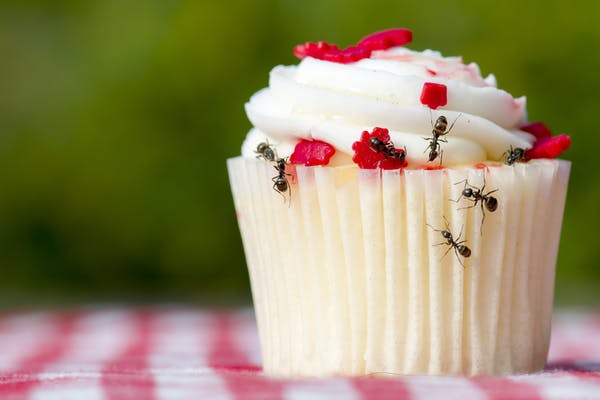
Let them eat cake. Image via Shutterstock.
3. After sex, queens don’t eat for weeks
When the conditions are warm and humid, the winged virgin queens and males leave their nests in search of mates. This is the behavior seen on “flying ant day”. In L. niger, mating takes place on the wing, often hundreds of meters [yards] up (hence the need for good weather). Afterwards, queens drop to the ground and shed their wings, while males quickly die. Mated queens choose a nest site and burrow into the soil, made softer from recent rain.
Once underground, the queens will not eat for weeks – until they have produced their own daughter workers. They use energy from their fat stores and redundant flight muscles to lay their first batch of eggs, which they fertilize using sperm stored from their nuptial flight. It is the same stock of sperm acquired from long dead males that allows a queen to continue laying fertilized eggs for her entire life. Queens never mate again.
4. Home-making the ant way is about cooperation, death and slavery
Sometimes two L. niger queens unite to found a nest. This initially cooperative association – which increases the chance of establishing a colony – dissolves once new adult workers emerge and then the queens fight to the death. More sinister still, L. niger colonies sometimes steal brood from their neighbors, putting them to work as slaves.
Slave-making has evolved in a number of ant species, but they also display cooperation at extraordinary levels. An extreme example of this is a “supercolony” of Argentine ants (Linepithema humile) which extends over 3,700 miles (6,000 km) of European coastline from Italy to northwest Spain, and is composed of literally billions of workers from millions of cooperating nests.
5. Queen ants can live for decades, males for a week
After establishing her colony, the queen’s work is not done and she has many years of egg-laying ahead of her. In the laboratory, L. niger queens have lived for nearly 30 years. Workers live for about a year, males little more than a week (although their sperm live longer). These extraordinary differences in longevity are purely due to the way their genes are switched on and off.
6. Ants can help humans and the environment
Ants have a major influence in ecosystems worldwide and their roles are diverse. While some ants are considered pests, others act as biological-control agents. Ants benefit ecosystems by dispersing seeds, pollinating plants and improving the quality of soil. Ants might also benefit our health, as a potential source of new medicines such as antibiotics.
So when you next see an ant, before you think to kill her, consider how fascinating she really is.
Charlie Durant, Ph.D. candidate, Department of Genetics and Genome Biology, University of Leicester; Max John, Ph.D. candidate, Department of Genetics and Genome Biology, University of Leicester, and Rob Hammond, lecturer, Department of Genetics and Genome Biology, University of Leicester
This article is republished from The Conversation under a Creative Commons license. Read the original article.
Bottom line: Facts about ants.
Grow up
A wise man once said that the most profound mantra of all is "grow up." Growing up doesn't mean we forget to smile, or play, or wonder at the ordinary magic of the present moment.
Growing up means we stop projecting our issues onto others. That we can begin to own blame. That we treat ourselves with kindness. That we practice waking up through meditation, again and again.
Growing up means we get to be of service to this confused, wonderful world.
Friday, 28 June 2019
Lemonade
MAKES2 quarts
INGREDIENTS
EQUIPMENT
- Measuring cup or medium bowl
- Knife and cutting board
- Juicer or citrus reamer, or stand mixer with the paddle attachment
- Pitcher
- Fine-mesh strainer
INSTRUCTIONS
- Juice the lemons and strain out the pulp. Halve the lemons, then squeeze the juice from the halves — you can do this manually with your favorite juicer or reamer. My favorite alternative method: Quarter the lemons and use the stand mixer to juice all of the lemons at once. Place the quartered lemons in a stand mixer fitted with the paddle attachment, then beat on low speed for 2 minutes. With either method, strain the juice through a fine-mesh strainer into a large measuring cup or bowl to remove the pulp before making the lemonade. You need 1 cup of strained lemon juice.
- Combine the lemon juice and sugar to make a lemonade base. Add the sugar to the strained lemon juice and whisk until the sugar is completely dissolved.
- Add the water and chill. Transfer the lemonade base to a serving pitcher. Add the water and stir to combine. Chill the lemonade for at least 1 hour before serving.
- Serve with ice and lemon slices. Serve the lemonade over ice with lemon slices if desired.
RECIPE NOTES
Storage: The lemonade can be refrigerated for up to 4 days.
Key Steps for Simple Easy Homemade Lemonade
Juice and strain the lemons. There a couple of tricks for getting the most juice out of your lemons (rolling them, slicing them lengthwise, roasting them), but my new favorite “juicing hack” is to actually crush the whole lemons using my stand mixer. Seriously! Here’s how you do it: Quarter the lemons and put them in the bowl of your stand mixer with the paddle attachment. Use low speed to squeeze the lemons, then strain the juice directly into a measuring cup.
Use the lemon juice to dissolve the sugar. Many modern lemonade recipes call for making a simple syrup — sugar and water boiled together — for sweetening summer lemonade, but if you stir the sugar directly into the lemon juice you can skip the simple syrup and get to lemonade faster — no heat required.
Add cold water to taste. Since the lemon juice dissolves the sugar, we can go straight from lemon juice to cold water and ice and serve the lemonade straight away.









